Changes in PRIMAP-hist v2.6_final compared to v2.5.1_final for Latvia
2024-09-24
Johannes Gütschow
Change analysis for Latvia for PRIMAP-hist v2.6_final compared to v2.5.1_final
Overview over emissions by sector and gas
The following figures show the aggregate national total emissions excluding LULUCF AR6GWP100 for the country reported priority scenario. The dotted linesshow the v2.5.1_final data.
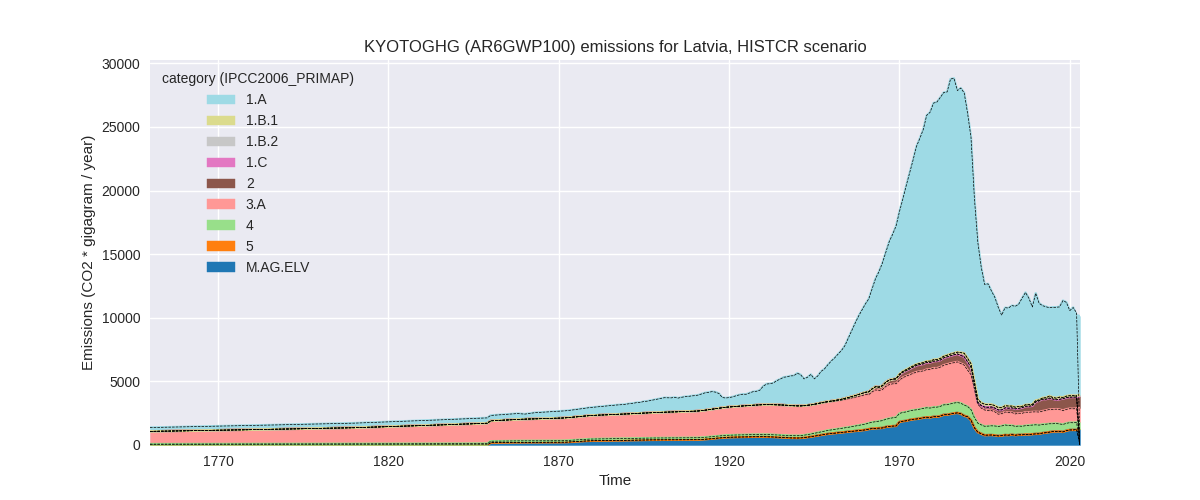
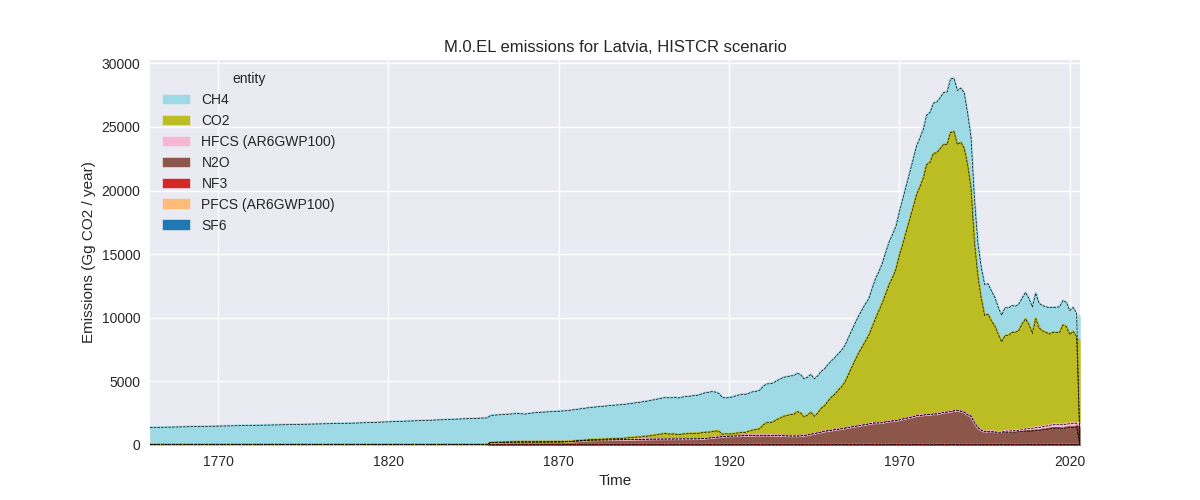
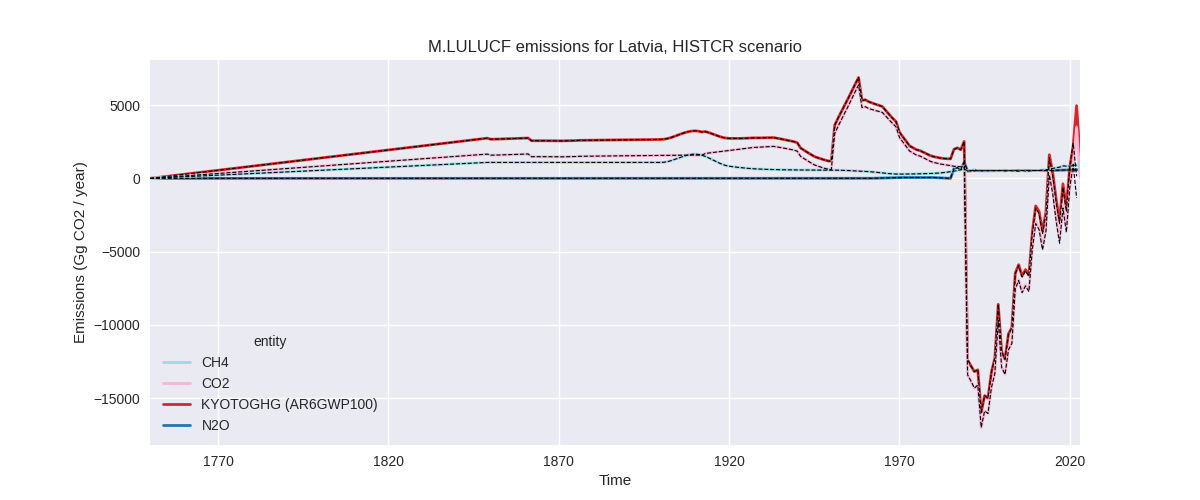
The following figures show the aggregate national total emissions excluding LULUCF AR6GWP100 for the third party priority scenario. The dotted linesshow the v2.5.1_final data.
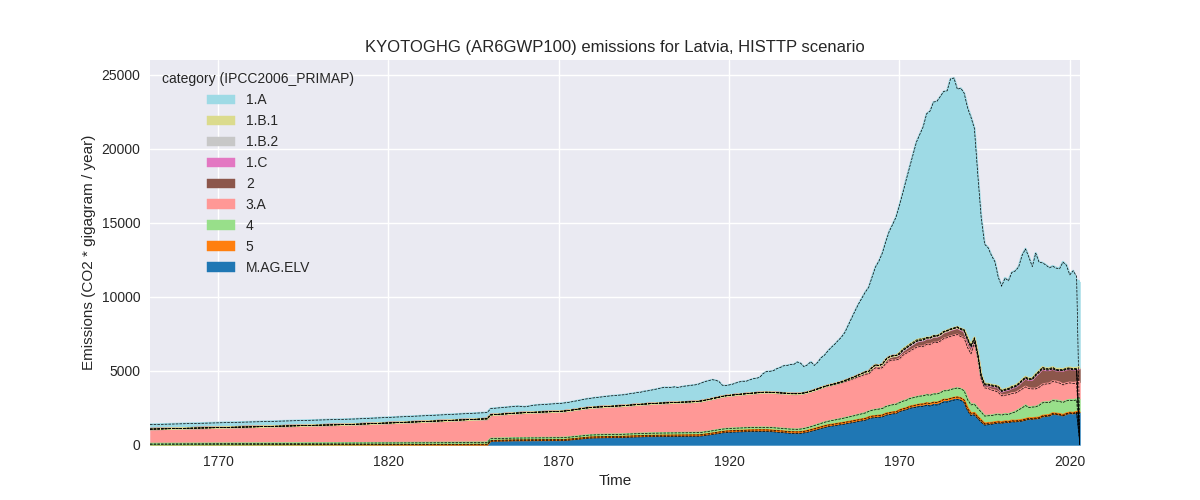
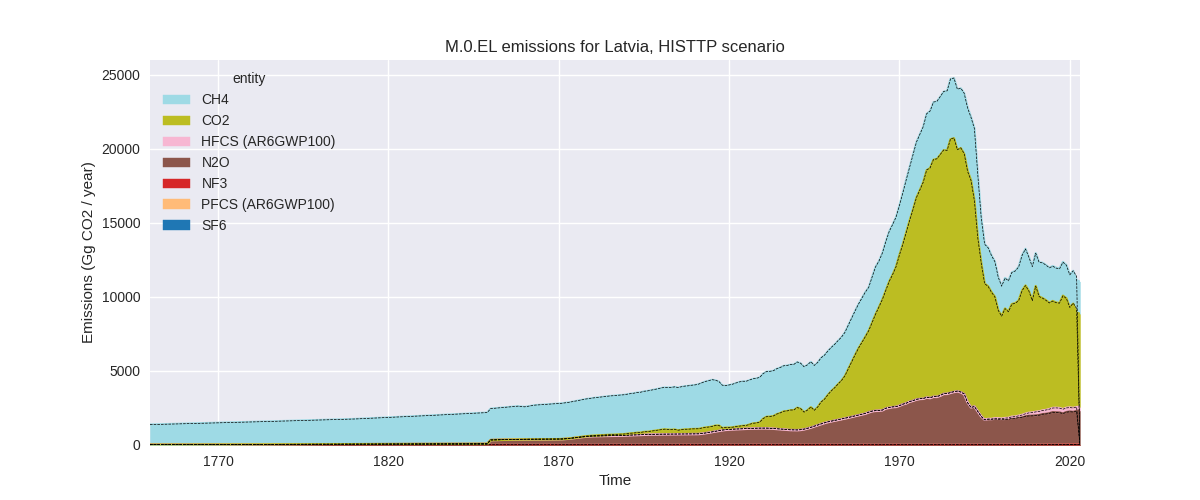
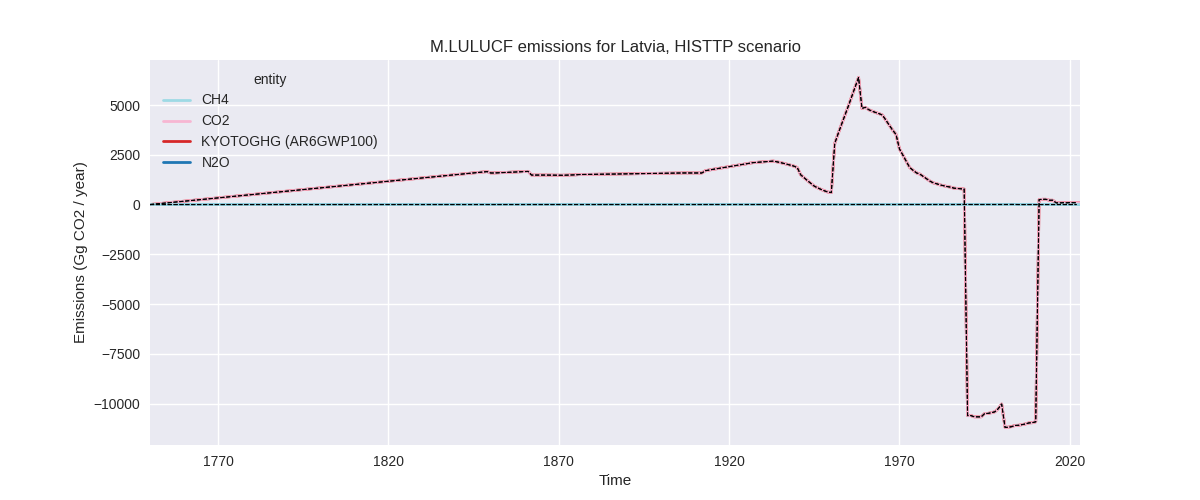
Overview over changes
In the country reported priority scenario we have the following changes for aggregate Kyoto GHG and national total emissions excluding LULUCF (M.0.EL):
- Emissions in 2022 have changed by -1.7%% (-179.97 Gg CO2 / year)
- Emissions in 1990-2022 have changed by -0.0%% (-4.91 Gg CO2 / year)
In the third party priority scenario we have the following changes for aggregate Kyoto GHG and national total emissions excluding LULUCF (M.0.EL):
- Emissions in 2022 have changed by -2.3%% (-264.07 Gg CO2 / year)
- Emissions in 1990-2022 have changed by -0.0%% (-4.24 Gg CO2 / year)
Most important changes per scenario and time frame
In the country reported priority scenario the following sector-gas combinations have the highest absolute impact on national total KyotoGHG (AR6GWP100) emissions in 2022 (top 5):
- 1: 1.A, CO2 with -173.17 Gg CO2 / year (-2.8%)
- 2: M.AG.ELV, N2O with -32.43 Gg CO2 / year (-2.9%)
- 3: 4, CH4 with 25.21 Gg CO2 / year (4.9%)
- 4: 3.A, CH4 with 15.96 Gg CO2 / year (1.5%)
- 5: 1.B.2, CH4 with -12.61 Gg CO2 / year (-11.4%)
In the country reported priority scenario the following sector-gas combinations have the highest absolute impact on national total KyotoGHG (AR6GWP100) emissions in 1990-2022 (top 5):
- 1: 1.A, CO2 with -5.47 Gg CO2 / year (-0.1%)
- 2: 2, HFCS (AR6GWP100) with 1.33 Gg CO2 / year (0.8%)
- 3: 4, N2O with 1.19 Gg CO2 / year (2.5%)
- 4: 2, CO2 with -1.17 Gg CO2 / year (-0.3%)
- 5: M.AG.ELV, N2O with -0.98 Gg CO2 / year (-0.1%)
In the third party priority scenario the following sector-gas combinations have the highest absolute impact on national total KyotoGHG (AR6GWP100) emissions in 2022 (top 5):
- 1: 1.A, CO2 with -283.89 Gg CO2 / year (-4.9%)
- 2: 4, CH4 with 32.63 Gg CO2 / year (4.2%)
- 3: 2, HFCS (AR6GWP100) with -16.77 Gg CO2 / year (-5.9%)
- 4: 5, N2O with 1.74 Gg CO2 / year (4.5%)
- 5: 2, CO2 with 1.50 Gg CO2 / year (0.2%)
In the third party priority scenario the following sector-gas combinations have the highest absolute impact on national total KyotoGHG (AR6GWP100) emissions in 1990-2022 (top 5):
- 1: 1.A, CO2 with -9.97 Gg CO2 / year (-0.1%)
- 2: 4, CH4 with 3.98 Gg CO2 / year (0.6%)
- 3: 5, N2O with 1.15 Gg CO2 / year (1.6%)
- 4: 4, N2O with 0.87 Gg CO2 / year (1.7%)
- 5: 2, HFCS (AR6GWP100) with -0.51 Gg CO2 / year (-0.3%)
Notes on data changes
Here we list notes explaining important emissions changes for the country. ’' means that the following text only applies to the TP time series, while means that it only applies to the CR scenario. Otherwise the note applies to both scenarios.
- We have added EEA 2024 data. The 2022 changes in the CR time-series come from differences between EEA and third party data used in PRIMAP-hist v2.5.1.
- 2022 changes in the TP scenario are from updated input data as well (HFCs use EEA data growth rates for 2022).
- Changes in cumulative emissions are very small for both the CR and the TP scenario
- Changes in sectors 4 and 5 in the TP scenario are due to the removal of FAOSTAT data.
Changes by sector and gas
For each scenario and time frame the changes are displayed for all individual sectors and all individual gases. In the sector plot we use aggregate Kyoto GHGs in AR6GWP100. In the gas plot we usenational total emissions without LULUCF. ## country reported scenario
2022
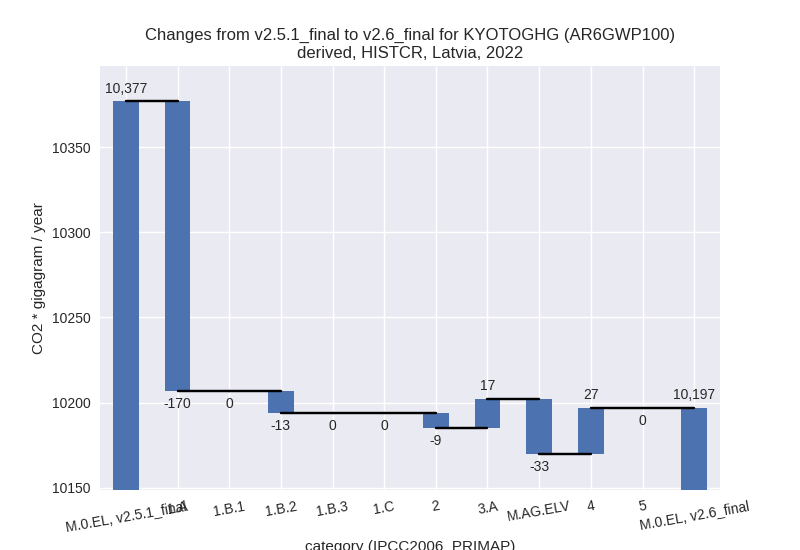
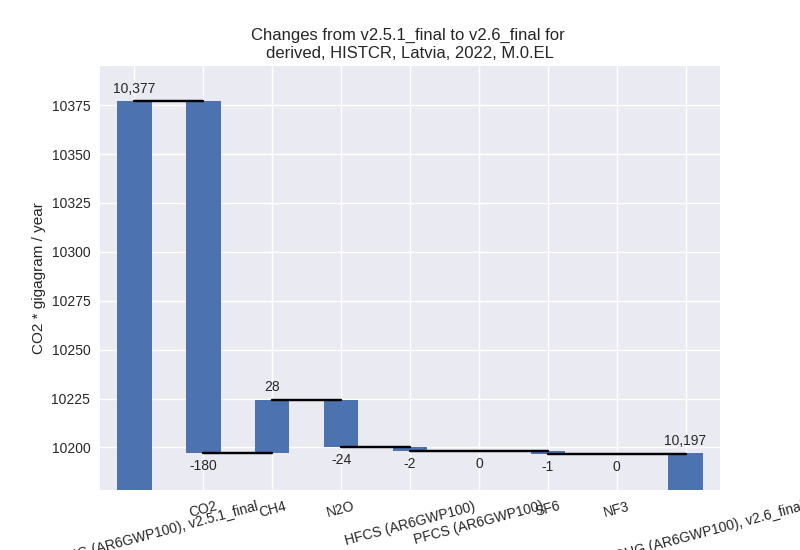
1990-2022
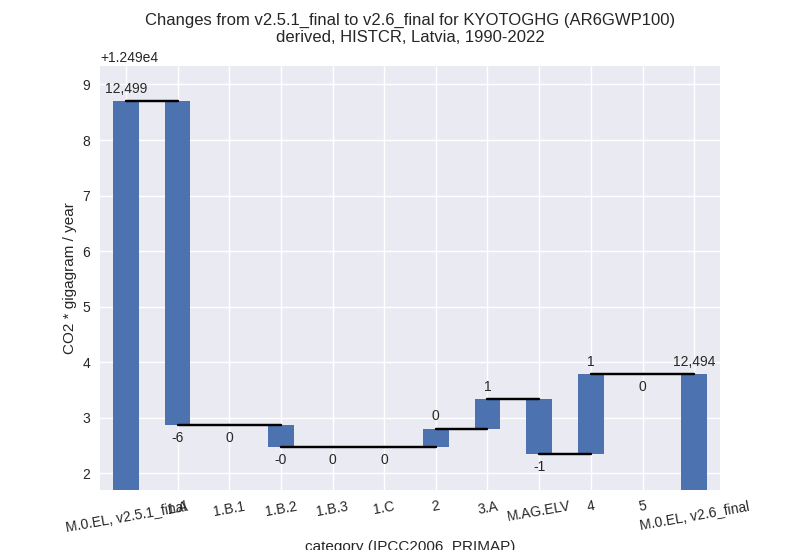

third party scenario
2022
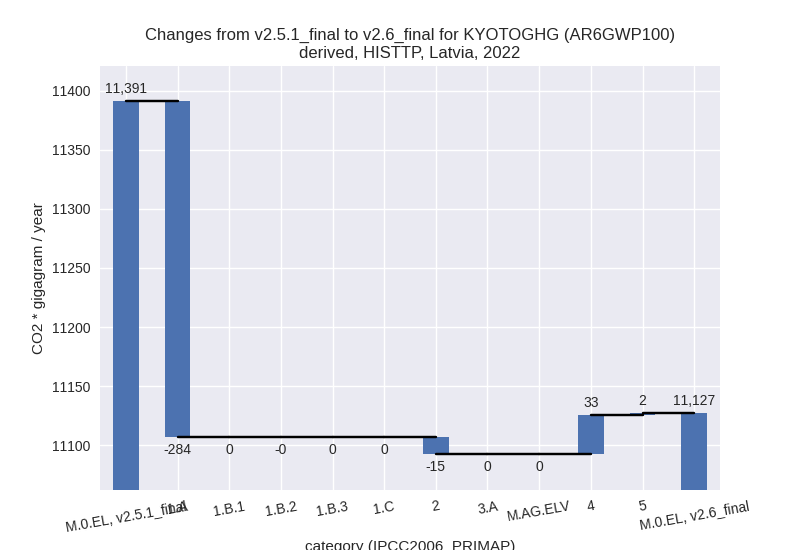
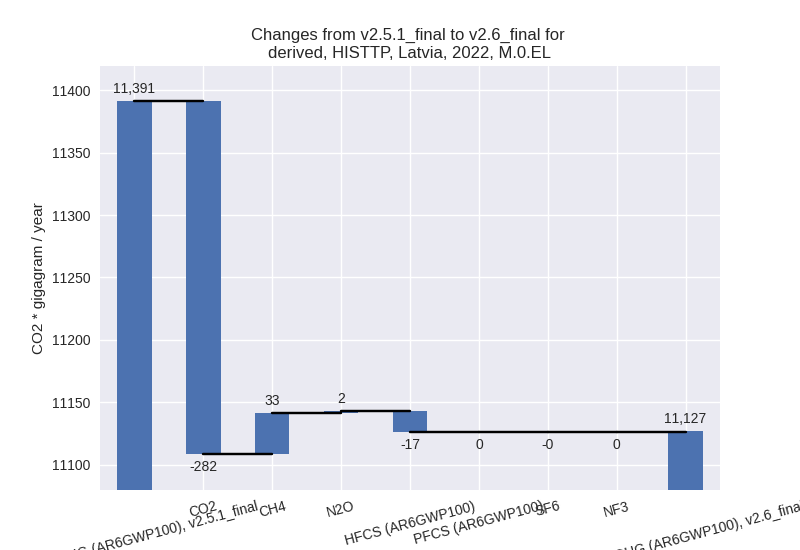
1990-2022

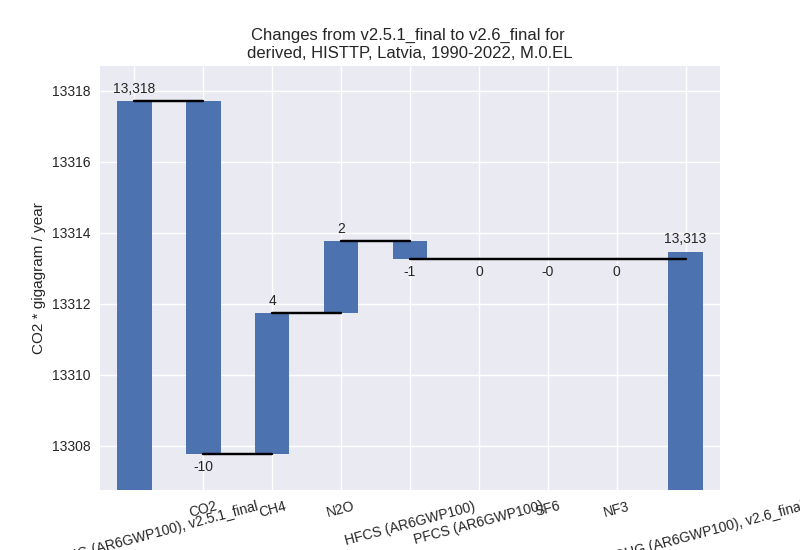
Detailed changes for the scenarios:
country reported scenario (HISTCR):
Most important changes per time frame
For 2022 the following sector-gas combinations have the highest absolute impact on national total KyotoGHG (AR6GWP100) emissions in 2022 (top 5):
- 1: 1.A, CO2 with -173.17 Gg CO2 / year (-2.8%)
- 2: M.AG.ELV, N2O with -32.43 Gg CO2 / year (-2.9%)
- 3: 4, CH4 with 25.21 Gg CO2 / year (4.9%)
- 4: 3.A, CH4 with 15.96 Gg CO2 / year (1.5%)
- 5: 1.B.2, CH4 with -12.61 Gg CO2 / year (-11.4%)
For 1990-2022 the following sector-gas combinations have the highest absolute impact on national total KyotoGHG (AR6GWP100) emissions in 1990-2022 (top 5):
- 1: 1.A, CO2 with -5.47 Gg CO2 / year (-0.1%)
- 2: 2, HFCS (AR6GWP100) with 1.33 Gg CO2 / year (0.8%)
- 3: 4, N2O with 1.19 Gg CO2 / year (2.5%)
- 4: 2, CO2 with -1.17 Gg CO2 / year (-0.3%)
- 5: M.AG.ELV, N2O with -0.98 Gg CO2 / year (-0.1%)
Changes in the main sectors for aggregate KyotoGHG (AR6GWP100) are
- 1: Total sectoral emissions in 2022 are 6423.09 Gg
CO2 / year which is 63.0% of M.0.EL emissions. 2022 Emissions have
changed by -2.8% (-182.86 Gg CO2 /
year). 1990-2022 Emissions have changed by -0.1% (-6.23 Gg CO2 / year). For 2022 the
changes per gas
are:
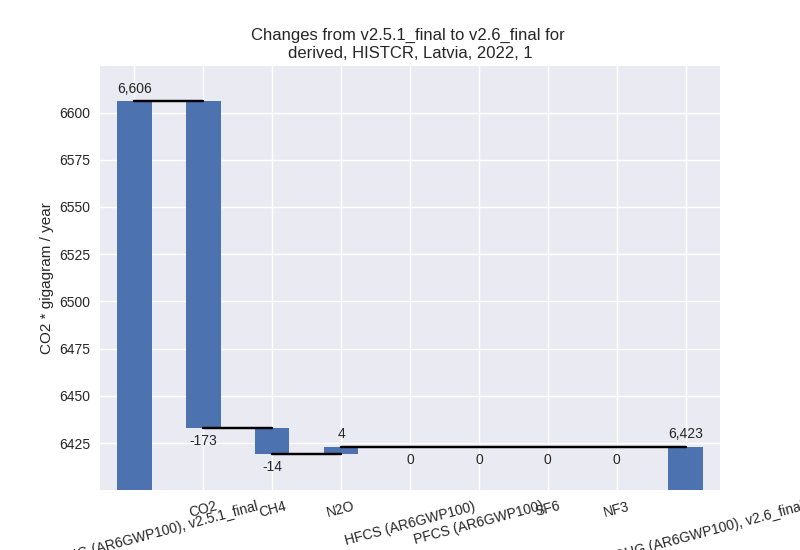
The changes come from the following subsectors:- 1.A: Total sectoral emissions in 2022 are 6324.99
Gg CO2 / year which is 98.5% of category 1 emissions. 2022 Emissions
have changed by -2.6% (-170.25 Gg
CO2 / year). 1990-2022 Emissions have changed by -0.1% (-5.83 Gg CO2 / year). For 2022 the
changes per gas
are:
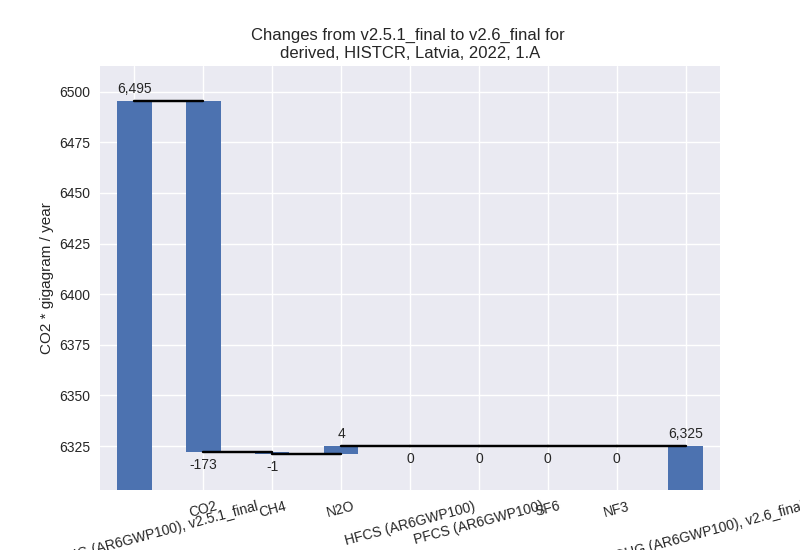
There is no subsector information available in PRIMAP-hist. - 1.B.2: Total sectoral emissions in 2022 are 98.10
Gg CO2 / year which is 1.5% of category 1 emissions. 2022 Emissions have
changed by -11.4% (-12.62 Gg CO2 /
year). 1990-2022 Emissions have changed by -0.3% (-0.40 Gg CO2 / year). For 2022 the
changes per gas
are:
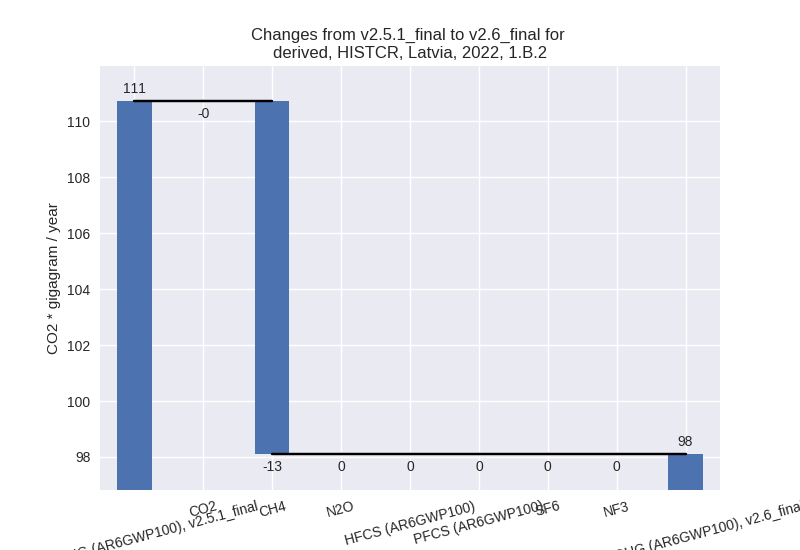
There is no subsector information available in PRIMAP-hist.
- 1.A: Total sectoral emissions in 2022 are 6324.99
Gg CO2 / year which is 98.5% of category 1 emissions. 2022 Emissions
have changed by -2.6% (-170.25 Gg
CO2 / year). 1990-2022 Emissions have changed by -0.1% (-5.83 Gg CO2 / year). For 2022 the
changes per gas
are:
- 2: Total sectoral emissions in 2022 are 902.02 Gg CO2 / year which is 8.8% of M.0.EL emissions. 2022 Emissions have changed by -1.0% (-9.22 Gg CO2 / year). 1990-2022 Emissions have changed by 0.1% (0.34 Gg CO2 / year).
- M.AG: Total sectoral emissions in 2022 are 2283.72 Gg CO2 / year which is 22.4% of M.0.EL emissions. 2022 Emissions have changed by -0.7% (-15.23 Gg CO2 / year). 1990-2022 Emissions have changed by -0.0% (-0.46 Gg CO2 / year).
- 4: Total sectoral emissions in 2022 are 588.21 Gg
CO2 / year which is 5.8% of M.0.EL emissions. 2022 Emissions have
changed by 4.9% (27.35 Gg CO2 /
year). 1990-2022 Emissions have changed by 0.2% (1.44 Gg CO2 / year). For 2022 the
changes per gas
are:
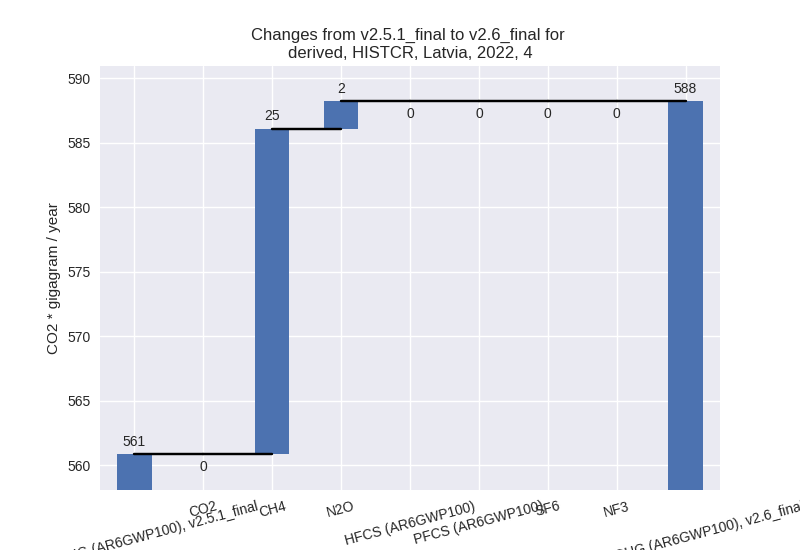
- 5: No data
third party scenario (HISTTP):
Most important changes per time frame
For 2022 the following sector-gas combinations have the highest absolute impact on national total KyotoGHG (AR6GWP100) emissions in 2022 (top 5):
- 1: 1.A, CO2 with -283.89 Gg CO2 / year (-4.9%)
- 2: 4, CH4 with 32.63 Gg CO2 / year (4.2%)
- 3: 2, HFCS (AR6GWP100) with -16.77 Gg CO2 / year (-5.9%)
- 4: 5, N2O with 1.74 Gg CO2 / year (4.5%)
- 5: 2, CO2 with 1.50 Gg CO2 / year (0.2%)
For 1990-2022 the following sector-gas combinations have the highest absolute impact on national total KyotoGHG (AR6GWP100) emissions in 1990-2022 (top 5):
- 1: 1.A, CO2 with -9.97 Gg CO2 / year (-0.1%)
- 2: 4, CH4 with 3.98 Gg CO2 / year (0.6%)
- 3: 5, N2O with 1.15 Gg CO2 / year (1.6%)
- 4: 4, N2O with 0.87 Gg CO2 / year (1.7%)
- 5: 2, HFCS (AR6GWP100) with -0.51 Gg CO2 / year (-0.3%)
Changes in the main sectors for aggregate KyotoGHG (AR6GWP100) are
- 1: Total sectoral emissions in 2022 are 5998.22 Gg
CO2 / year which is 53.9% of M.0.EL emissions. 2022 Emissions have
changed by -4.5% (-283.90 Gg CO2 /
year). 1990-2022 Emissions have changed by -0.1% (-9.97 Gg CO2 / year). For 2022 the
changes per gas
are:
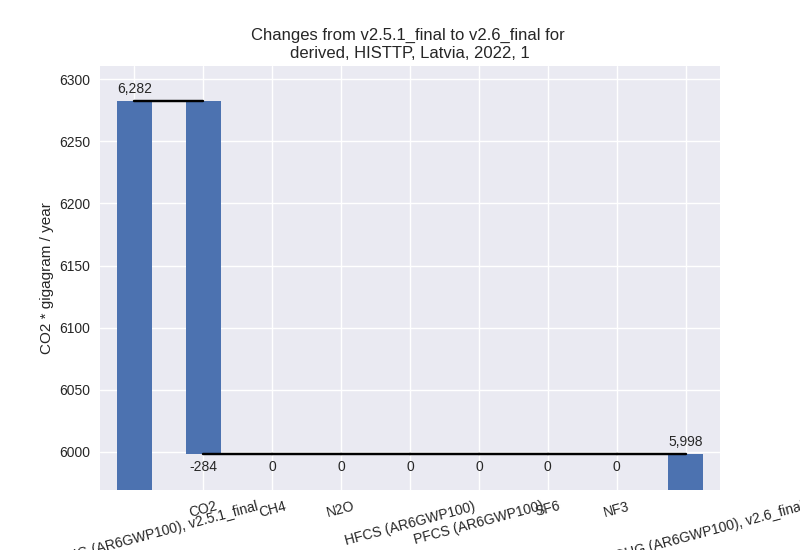
The changes come from the following subsectors:- 1.A: Total sectoral emissions in 2022 are 5924.13
Gg CO2 / year which is 98.8% of category 1 emissions. 2022 Emissions
have changed by -4.6% (-283.89 Gg
CO2 / year). 1990-2022 Emissions have changed by -0.1% (-9.97 Gg CO2 / year). For 2022 the
changes per gas
are:
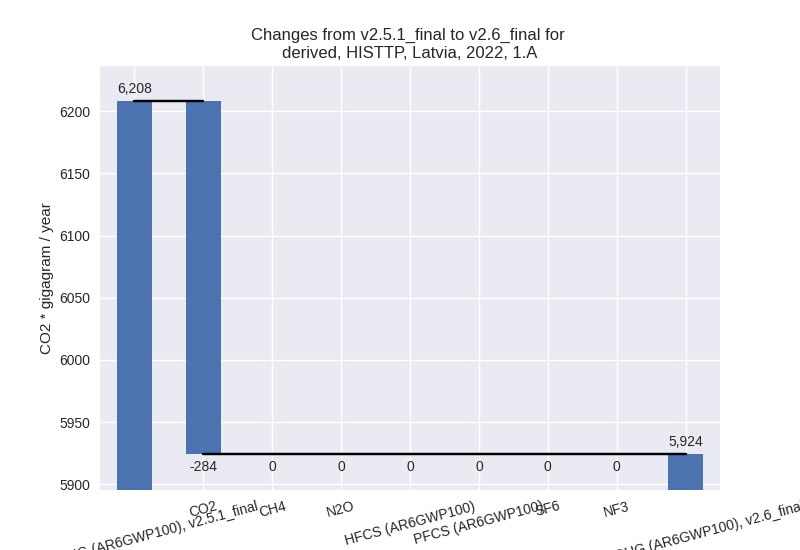
There is no subsector information available in PRIMAP-hist. - 1.B.1: Total sectoral emissions in 2022 are 21.78 Gg CO2 / year which is 0.4% of category 1 emissions. 2022 Emissions have changed by 0.0% (0.00 Gg CO2 / year). 1990-2022 Emissions have changed by 0.0% (0.00 Gg CO2 / year).
- 1.B.2: Total sectoral emissions in 2022 are 52.31 Gg CO2 / year which is 0.9% of category 1 emissions. 2022 Emissions have changed by -0.0% (-0.01 Gg CO2 / year). 1990-2022 Emissions have changed by -0.0% (-0.00 Gg CO2 / year).
- 1.A: Total sectoral emissions in 2022 are 5924.13
Gg CO2 / year which is 98.8% of category 1 emissions. 2022 Emissions
have changed by -4.6% (-283.89 Gg
CO2 / year). 1990-2022 Emissions have changed by -0.1% (-9.97 Gg CO2 / year). For 2022 the
changes per gas
are:
- 2: Total sectoral emissions in 2022 are 911.72 Gg CO2 / year which is 8.2% of M.0.EL emissions. 2022 Emissions have changed by -1.6% (-14.66 Gg CO2 / year). 1990-2022 Emissions have changed by -0.0% (-0.25 Gg CO2 / year).
- M.AG: Total sectoral emissions in 2022 are 3311.22 Gg CO2 / year which is 29.8% of M.0.EL emissions. 2022 Emissions have changed by 0.0% (0.00 Gg CO2 / year). 1990-2022 Emissions have changed by 0.0% (0.00 Gg CO2 / year).
- 4: Total sectoral emissions in 2022 are 865.32 Gg
CO2 / year which is 7.8% of M.0.EL emissions. 2022 Emissions have
changed by 3.9% (32.75 Gg CO2 /
year). 1990-2022 Emissions have changed by 0.7% (4.83 Gg CO2 / year). For 2022 the
changes per gas
are:
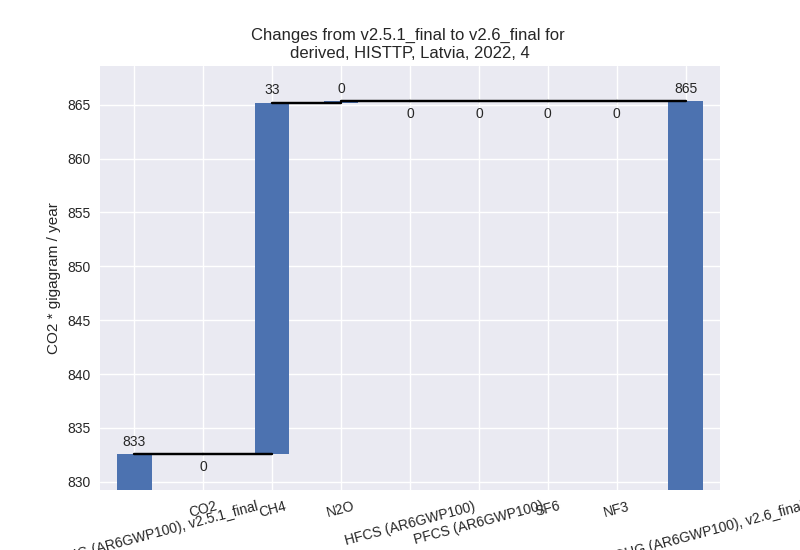
- 5: Total sectoral emissions in 2022 are 40.44 Gg
CO2 / year which is 0.4% of M.0.EL emissions. 2022 Emissions have
changed by 4.5% (1.74 Gg CO2 /
year). 1990-2022 Emissions have changed by 1.6% (1.15 Gg CO2 / year). For 2022 the
changes per gas
are:
